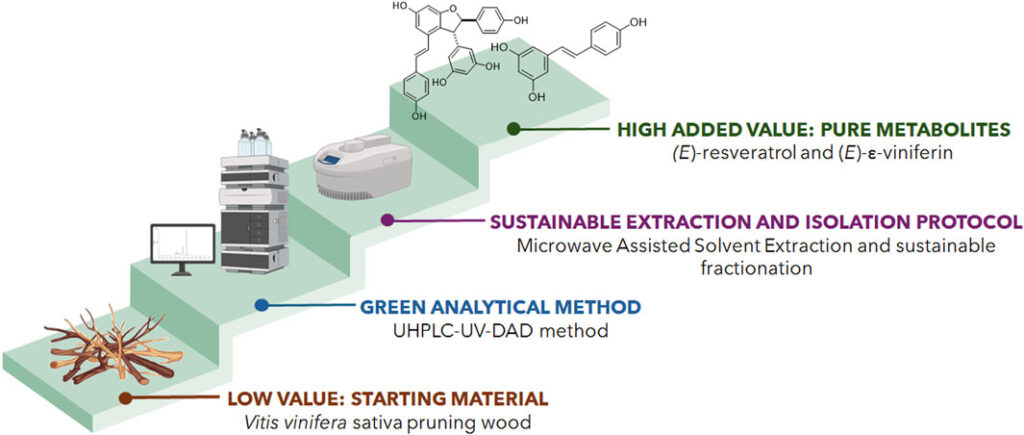Tumminelli, E.; Cavalloro, V.; Ingrà, C.; Ferrandino, A.; Porta, A.; Marrubini, G.; Martino, E., Rossi D.; Collina, S.
(2025) Front. Chem., 13 1597833
DOI: 10.3389/fchem.2025.1597833
ABSTRACT:
Introduction: The annual production of waste is expected to increase over the next forty years, representing one of the main challenges associated with the global rise in population. Consequently, the transition towards more sustainable development and circular economy constitutes one of the most pressing challenges in the coming decades. Vineyard management generates several thousand tons of waste each year, including wood from pruning. This waste material is particularly rich in secondary metabolites, such as (E)-resveratrol and (E)-ε-viniferin. Accordingly, it represents a valuable source of biologically active phytochemicals with potential industrial outcomes.
Methods: The present study aimed to exploit grapevine pruning residues as a source of (E)-resveratrol and (E)-ε-viniferin through the set-up of a low environmental impact procedure which involves first a microwave-assisted solvent extraction (MASE) followed by a protocol suitable for the isolation of (E)-resveratrol and (E)-ε-viniferin from the MASE extract. Different purification techniques, such as liquid/liquid extraction and chromatography, alone or in combinations, were exploited.
Results and Discussion: Our optimized MASE protocol involves 100% EtOH as extraction solvent, 1 microwave cycle of 5 minutes at 80°C. As regards the isolation procedure, best results were achieved with medium pressure automated chromatography, eluting with n-hexane and ethyl acetate in gradient condition, with or without preliminary liquid/liquid (water/ethyl acetate) extraction. Applying the optimize procedure (E)-resveratrol (0.9 mg/g dry matrix weight) and (E)-ε-viniferin (1.1 mg/g dry matrix weight) were successfully isolated with high purity Moreover, a UHPLC-UV/DAD method suitable for the quantification of (E)-resveratrol and (E)-ε-viniferin was developed to support all the procedures. Keeping in mind eco-sustainable criteria, the greenness of the UHPLC method was evaluated through the open source calculator AGREE: analytical GREennEss Calculator 0.5 beta, while the environmental impact of the whole procedure proposed for the extraction and the isolation of the secondary metabolites was determined using the environmental impact factor (EF), obtaining satisfactory results.

